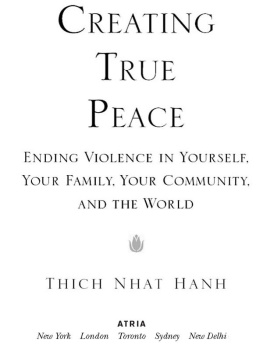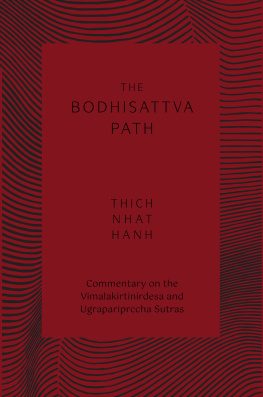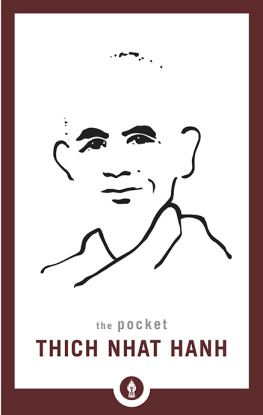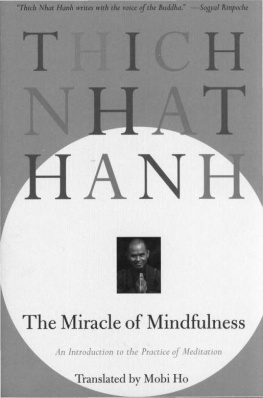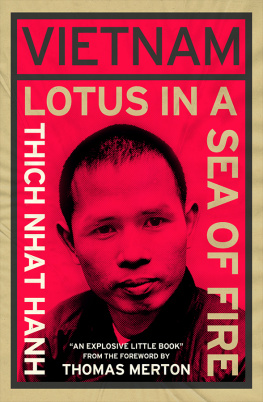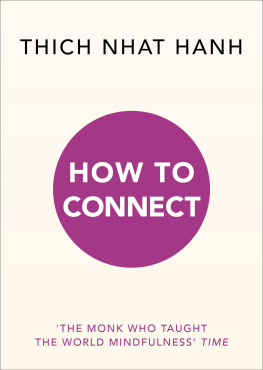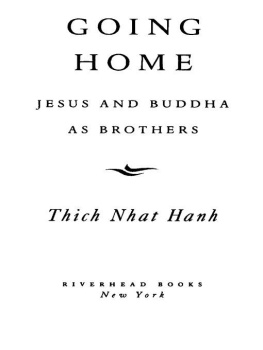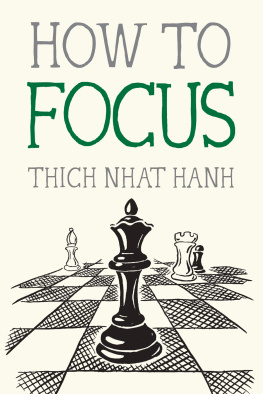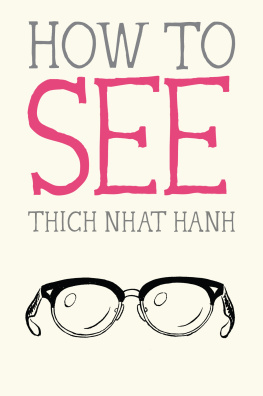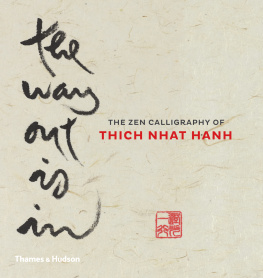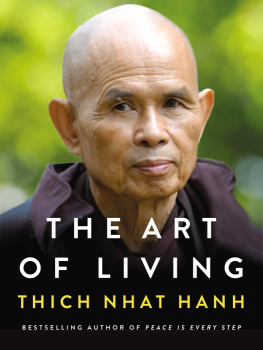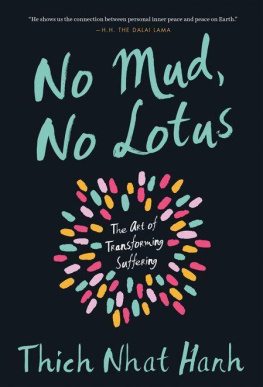HERMITAGE AMONG THE CLOUDS
Other Books by Thich Nhat Hanh
Being Peace
The Blooming of a Lotus:
Guided Meditation Exercises for Healing and Transformation
Breathe! You Are Alive: Sutra on the Full Awareness of Breathing
Call Me by My True Names:
The Collected Poems of Thich Nhat Hanh
The Diamond That Cuts through Illusion:
Commentaries on the Prajaparamita Diamond Sutra
For a Future to Be Possible:
Commentaries on the Five Wonderful Precepts
A Guide to Walking Meditation
The Heart of Understanding:
Commentaries on the Prajaparamita Heart Sutra
Interbeing: Fourteen Guidelines for Engaged Buddhism
(Revised Edition)
Love in Action: Writings on Nonviolent Social Change
The Miracle of Mindfulness: A Manual on Meditation
The Moon Bamboo
Old Path White Clouds: Walking in the Footsteps of the Buddha
Our Appointment with Life:
Buddhas Teaching on Living in the Present
Peace Is Every Step: The Path of Mindfulness in Everyday Life
Present Moment Wonderful Moment:
Mindfulness Verses for Daily Living
The Sun My Heart: From Mindfulness to Insight Contemplation
A Taste of Earth and Other Legends of Vietnam
Thundering Silence:
Sutra on Knowing the Better Way to Catch a Snake
Touching Peace: Practicing the Art of Mindful Living
Transformation and Healing:
Sutra on the Four Establishments of Mindfulness

Hermitage
Among the Clouds

THICH NHAT HANH
Translated from the Vietnamese by
Mobi Warren and Annabel Laity

Parallax Press
Berkeley, California
Parallax Press
P.O. Box 7355
Berkeley, CA 94707
www.parallax.org
Copyright 1993, by Unified Buddhist Church
Translation 1993, by Mobi Warren and Annabel Laity
Drawings 1993, by Nguyen Thi Hop and Nguyen Dong
All rights reserved
Design by Ayelet Maida
LIBRARY OF CONGRESS CATALOGING-IN-PUBLICATION DATA
Nhat Hanh, Thich
(Am may ngu. English)
Hermitage Among the Clouds/Thich Nhat Hanh: translated from the Vietnamese by Mobi Warren and Annabel Laity.
p.cm.
ISBN 978-1-9352-0960-7
1. Trn, Nhn Tng, King of Vietnam, 1241-1294Fiction.
2. VietnamHistory939-1428Fiction.I. Title
PL4378.9.N55A813 1993
895'.92233dc20 | 93-30730
CIP |
3 4 5 6 / 15 14 13 12

CONTENTS

Thich Nhat Hanh
A lthough this is a story about the life of Princess Amazing Jewel, she is not separate from her father, who abdicated his throne to become a monk and live in the little hermitage Sleeping Clouds on Mount Yen Tu. He was known as the Noble Teacher of Bamboo Forest and was the founder of the Bamboo Forest School of Zen Meditation.
Before becoming a monk, the Noble Teacher was known as Tran Nhan Tong, and he ruled as king over the land of Viet. He repelled the invading Mongol army at the end of the thirteenth century. From the day he was ordained a monk, he lived an ascetic lifewearing coarse cloth, sleeping under a roof of leaves, and going everywhere barefoot. Even as a monk, he continued his work to establish justice and morality in the culture of his people. He travelled to the land of Cham in hopes of establishing a foundation of lasting friendship and peace between the two countries. Princess Amazing Jewel laid the very foundation stone of this aspiration for peace between Cham and Viet.
As a monk myself, I have tried to recount the story from within the heart and mind of this illustrious monk, the Noble Teacher of Bamboo Forest.
The country to the south of Viet roughly between present-day Hue in the north and Nha Trang in the south.

Reading Hermitage Among the Clouds
Mobi Warren, co-translator
D uring the months I was working on the translation of Hermitage Among the Clouds, I frequently told interested friends that it was a historical novel. This was usually followed by my explanations that it wasnt really a historical novel in the sense Western readers might understand that term. It was also a stream of consciousness, a how-to manual on lighting a Vietnamese stove, a celebration of the Buddhas nativity. I described my translators dilemma about how to best make this novel work for the Western reader. I intended to significantly restructure the book in order to make it more accessible to the Western reader, but couldnt dispel an inner resistance to tampering with the book in such a way.
A struggle was going on inside me, one to which other translators can no doubt relate. I felt torn between my sympathy for the Western reader (wanting to provide a book that could be read with the same ease a Vietnamese Buddhist would feel in reading the original), and my desire to preserve the authors literary structure. Structure cannot be so neatly separated from the meaning of a literary work. For one thing, structure shows us how the author actually thinks.
Students of Thich Nhat Hanh, as well as readers of his Dharma talks and sutra commentaries, often remark how accessible his words are. This has drawn many people to his style of practice. They are therefore puzzled when his fiction requires a different effort. Hermitage Among the Clouds, as much of Thich Nhat Hanhs fiction, is told almost entirely through the use of flashbacks. Flashbacks are often contained within flashbacks, strand coiled within strand within strand. Time frames blur. The order in which even basic facts are presented can seem illogical. The Western reader may ask why a certain piece of information wasnt mentioned several pages ago when it was more pertinent, or why an already stated fact is repeated, seemingly out of the blue? The answer is that ordinary Western concepts and literary conventions concerning time have little place here.
The characters in Hermitage Among the Clouds experience everything from within the present moment. Past, present, and future are interwoven and inseparable. Within the space of one moment, a person can simultaneously travel back twenty years, hold a conversation that took place twenty minutes ago in her or his thoughts, and appreciate the sound of a nearby stream. Actually, we all think in this manner all the time. Random thoughts from the past infuse every present thought. The past therefore becomes something dynamic and malleable, something that one can bring into the present moment in order to heal and transform. That healing makes Awakening in the present moment possible, and Awakening in the present moment makes healing the past possible. This is what the character Princess Amazing Jewel, who later becomes the nun Fragrant Garland, is doing throughout the book.
Admittedly, all this moving between past and present is more easily expressed in Vietnamese, a language in which none of the verbs have tenses. There are small indicator words that can be attached to verbs to indicate past or future, but they are often dispensed with since one can understand the meaning through context. It is possible in Vietnamese to move among different time frames with a great simplicity and ease of language. In English, with our required verb tenses, flashbacks can sound awkward and cumbersome. Our very language leads us towards a more linear structure because it sounds and feels more orderly and comfortable. Writers in English who experiment with different time frames often do so by infusing their language with a poetry that can temporarily suspend our attachment to the linear. What can be taken for granted in Vietnamese is more difficult to sustain in English.


